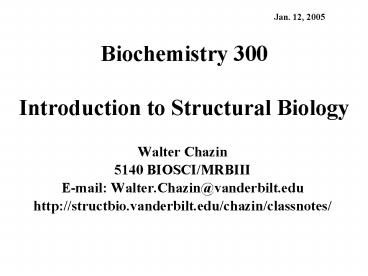Biochemistry 300 Introduction to Structural Biology - PowerPoint PPT Presentation
1 / 25
Title:
Biochemistry 300 Introduction to Structural Biology
Description:
Proper communication between these molecules is essential to the normal functioning ... Molecular simulations. Structure calculations (using experimental data) ... – PowerPoint PPT presentation
Number of Views:85
Avg rating:3.0/5.0
Title: Biochemistry 300 Introduction to Structural Biology
1
Biochemistry 300Introduction to Structural
Biology
Jan. 12, 2005
- Walter Chazin
- 5140 BIOSCI/MRBIII
- E-mail Walter.Chazin_at_vanderbilt.edu
- http//structbio.vanderbilt.edu/chazin/classnotes/
2
What is Structural Biology?
Sequence
Structural Scales
MESDAMESETMESSRSMYNAMEISWALTERYALLKINCALLMEWALLYIP
REFERDREVILMYSELFIMACENTERDIRATVANDYINTENNESSEEILI
KENMRANDDYNAMICSRPADNAPRIMASERADCALCYCLINNDRKINASE
MRPCALTRACTINKARKICIPCDPKIQDENVSDETAVSWILLWINITALL
polymerase
SSBs
Complexes
helicase
primase
Assemblies
Cell Structures
System Dynamics
3
Atomic Resolution Structural Biology
Organ ? Tissue ? Cell ? Molecule ? Atoms
- A cell is an organization of millions of
molecules - Proper communication between these molecules is
essential to the normal functioning of the cell - To understand communication Determine
the arrangement of atoms
4
Atomic Resolution Structural Biology
- Determine atomic structure to
- analyze why molecules interact
5
The Reward Understanding?Control
Shape
6
Atomic Structure in Context
7
The Strategy of Atomic Resolution Structural
Biology
- Break down complexity so that the system can be
understood at a fundamental level - Build up a picture of the whole from the
reconstruction of the high resolution pieces - Understanding basic governing principles enables
prediction, design, control - Pharmaceuticals, biotechnology
8
Build-up Quaternary Structure
70AB
14/32D/70C
X-ray
Zn
B
A
C
D
RPA70 RPA32 RPA14
NTD
NMR
14
CTD
70NTD
32CTD
quaternary structure?
9
Approaches to Atomic Resolution Structural Biology
- NMR Spectroscopy X-ray
Crystallography - Computation
- Determine experimentally or model 3D structures
of biomolecules - ESR/Fluorescence to build structures when
traditional methods fail - EM to get snapshots of whole molecular
structures - Cryo-EM starts to approach atomic resolution!
10
Experimental Determination of Atomic Resolution
Structures
11
Computational Approaches3D Structure From Theory
- Molecular simulations
- Structure calculations (using experimental data)
- Simulations of active molecules
- Characterization of chemical properties to infer
biological function (e.g. surface properties) - Prediction of protein structure (secondary only,
fold recognition, complete 3D)
12
Molecular Simulation
- Specify the forces that act on each atom
- Simulate these forces on a molecule and the
responses to changes in the system - Can use experimental data as a guide or an
approximate experimental structure to start - Many energy force fields in use all require
empirical treatment for biomacromolecules
13
Protein Structure PredictionWhy Attempt It?
- A good guess is better than nothing!
- Enables the design of experiments
- Potential for high-throughput
- Crystallography and NMR dont always work!
- Many important proteins do not crystallize
- Size limitations with NMR
14
Structure Prediction Methods
1 QQYTA KIKGR 11 TFRNE KELRD 21 FIEKF KGR
Algorithm
- Secondary structure (only sequence)
- Homology modeling (using related structure)
- Fold recognition
- Ab-initio 3D prediction The Holy Grail
15
Homology Modeling
- Assumes similar (homologous) sequences have very
similar tertiary structures - Basic structural framework is often the same
(same secondary structure elements packed in the
same way) - Loop regions differ
- Wide differences possible, even among closely
related proteins
16
Complementarity of the Methods
- X-ray crystallography- highest resolution
structures faster than NMR - NMR- enables widely varying solution conditions
characterization of motions and dynamic, weakly
interacting systems - Computation- fundamental understanding of
structure, dynamics and interactions (provides
the why answers) models without experiment very
fast
17
Representing Structures
- To correctly represent 3D structure (not a
model), the uncertainty in each atomic coordinate
must be represented - Polypeptides are dynamic and therefore occupy
more than one conformation
18
Representations of 3D Structures
Both accuracy and precision are important
19
Representation of Structure Conformational
Ensemble
- Neither crystal nor solution structures can be
properly represented by a single conformation - Intrinsic motions
- Imperfect data
Variability reflected in the RMSD of the ensemble
20
Variability Uncertainty and Flexibility in
Experimental Structures
21
Challenges For Understanding The Meaning of
Structure
- Structures determined by NMR, computation, and
X-ray crystallography are static snapshots of
highly dynamic molecular systems
- Biological process (recognition, interaction,
chemistry) require molecular motions (from
femto-seconds to minutes) - New methods are needed to comprehend and
facilitate thinking about the dynamic structure
of molecules visualization
22
Visualization of Structures
Intestinal Ca2-binding protein!
- Need to incorporate 3D and motion
23
Center for Structural Biology
Dedicated to furthering biomedical research and
education involving 3D structures at or near
atomic resolution
24
Center for Structural BiologyA Resource for
Structural Biology Research
- Dedicated to education and project origination
- Expertise- faculty plus expert scientific staff
- Access to instrumentation to determine and
visualize structures - Biophysical characterization- CD, fluorescence,
UV, calorimetry
25
Structural Biology Facilities
- X-ray crystallography
- Local facilities (Bruker- BIOSCI/MRB3, Oxford-
RRB) - Synchrotron crystallography (SER-CAT)
- Automated crystallization
- NMR
- Biomolecular NMR Facility (2-500, 2-600, 800)
- Computation/Graphics
- Throughput computing clusters
- Open-access graphics laboratory































